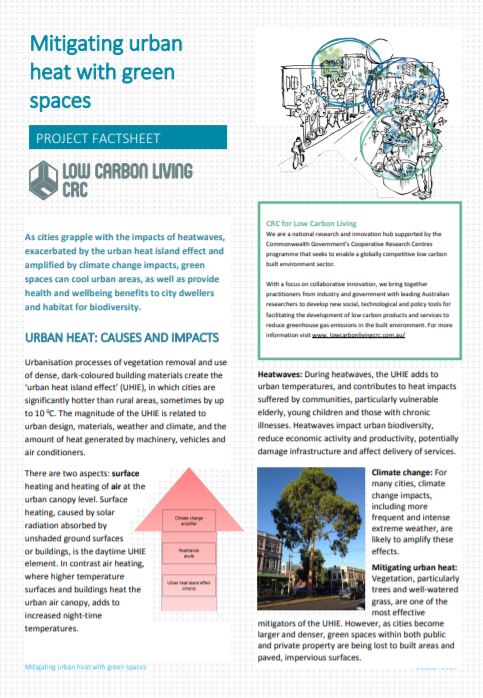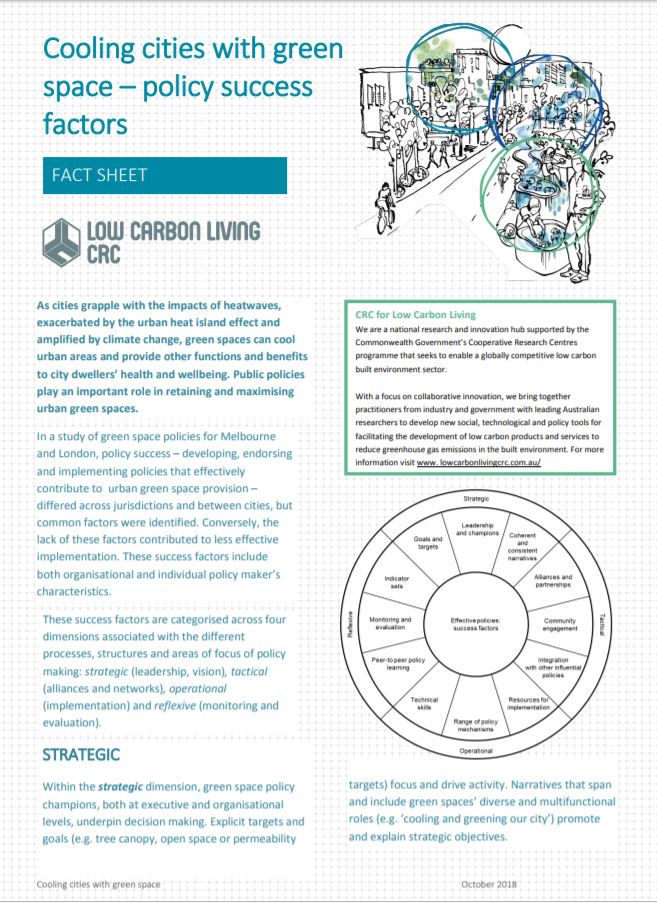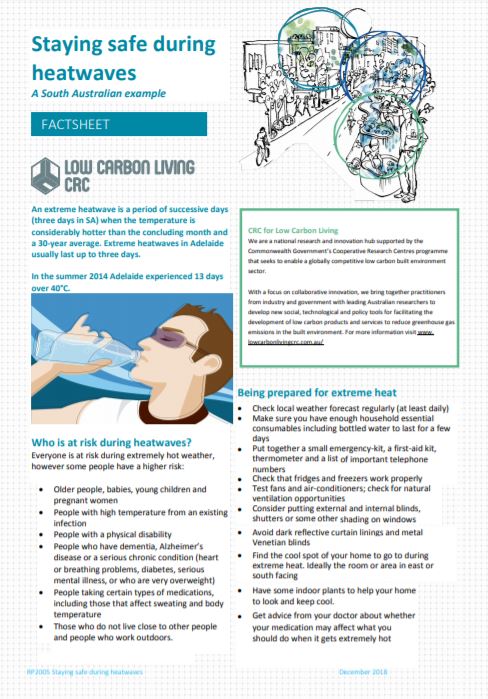
Since its launch in 2012, the CRCLCL has worked closely with industry and government to generate an authoritative body of research to help keep Australian cities cool.
The new evidence-based decision support tools, optimal development models and planning recommendations are equipping policymakers and planners to drive positive changes to cityscapes based on Australian conditions.
Professor John Boland, from the University of South Australia, led the CRCLCL’s first urban heat island (UHI) research to identify cost-effective strategies to mitigate localised heat effects in Adelaide, Sydney and Melbourne. While some 400 cities worldwide experience urban heat stress, Australian cities face unique challenges including the influence of inland deserts on city weather patterns and variable climate change impacts. Professor Boland’s team focused on creating heat resilience in urban environments to enable the continued enjoyment and health benefits of outdoor spaces.
 |
Aspects of this research were used in Australia’s first Guide to Urban Cooling Strategies authored by Associate Professor Paul Osmond, Director of the Sustainable Built Environment program at UNSW. The CRCLCL’s most popular publication to date, the guide details options for Australia’s different climate zones and is aimed at built environment professionals and regulatory agencies. Associate Professor Osmond believed the guide’s popularity revealed the “pent-up demand” from industries and governments around the world for user-friendly, evidence-based advice. After its publication, the global C40 Cities Climate Leadership Group approached him to present a webinar with the City of Tel Aviv, where authorities are trying to improve outdoor thermal comfort.
“Working with multiple industry partners through the CRC structure was both valuable and essential. The cooling strategies guide is a good example. The initiative actually came from our industry partners who said the research is great, but now we need something to help us apply the findings in the real world,” Associate Professor Osmond said.
Mat Santamouris, Professor of High Performance Architecture at UNSW, has continued the CRCLCL’s work in the field by testing potential UHI solutions in Western Sydney, where temperatures are often 6 to 10°C higher than in the city’s east, driving a doubling in consumption of electricity for cooling and a three-fold increase in heat-related deaths. Professor Santamouris’ team investigated eight areas in Sydney’s west including Parramatta and Penrith, where a record maximum temperature of 47.3°C was recorded in early 2018. Collaborating with Sydney Water, the team found that by integrating water-based technologies like fountains with ‘cool’ materials and vegetation, local temperatures could be reduced by between 2.5 and 2.8°C, with further work aiming for a 4°C reduction. Resulting use of cooling energy fell 35 per cent and peak electricity demand by 5 per cent.
The resulting Cooling Western Sydney report is now informing the redevelopment of Parramatta’s CBD. The city’s new main street is likely to include materials that reflect heat rather than absorb it, strategically placed water features and misting, shading and trees, and smart paving that can generate electricity via integrated photovoltaic cells or even by harnessing the kinetic energy of pedestrians.
Professor Santamouris is also collaborating with the Greater Sydney Commission to predict UHI conditions around the site of the new Western Sydney Airport and development hub, so that evidence-based cooling measures can be incorporated into its design from the outset.
Meanwhile, the CRCLCL is delivering a unique online support tool to help mitigate UHI effects by connecting policymakers, developers and planners to the best evidence-based analysis and solutions. The tool identifies heat risks within new plans and cross-references them to local climatic conditions.
The resulting scenario analysis can then be used to model a range of mitigating options at both the building and precinct scale, using 3D visualisation technologies and heat mapping.
Developer, UNSW Associate Professor Lan Ding, said the tool was “an important bridge” between research and its practical application. Sixteen industry and government partners, including major developers Landcom and Stockland, are involved in the project – evidence that building and regulatory professionals are keen to work with universities to improve outcomes.
Ding, Santamouris and Osmond are now combining their expertise to develop a Continuing Professional Development course, Managing Urban Heat, that will be available online from 2019. The course will facilitate the transfer of knowledge to planners, designers and landscapers, using interactive case studies developed in real-world conditions with CRCLCL partners.
What do our PhDs think?
“If we want to cool our cities, we need to understand that every building has a different heat ‘footprint’,” says UNSW PhD candidate, Jonathan Fox.
Fox’s research in Sydney focuses on how different building facades affect outdoor microclimates. While much research has focused on the heat effects of urban precincts, few studies have drilled down to the level of individual buildings and how they impact on their surroundings.
An architect turned academic, Fox is using precise weather observations at a building’s location to evaluate the performance of external materials and surfaces, like reflective facades. The result is a unique, predictive model of the heat impact of different materials under specific conditions.
Building performance is also the focus of Dr Gertrud Hatvani-Kovacs’ PhD research at the University of South Australia.
An architect and engineer, Hatvani-Kovacs is investigating ways to offset a building’s heat gain. She has recommended that Australia’s energy efficiency star-rating scheme for homes be modified to consider separate cooling and heating loads, not just total energy demand. She’s also warned against the excessive use of air conditioning which generates waste heat urther increasing outdoor temperatures. The research has informed the forthcoming National Construction Code 2019.
Dr Ehsan Sharifi believes planners need a better understanding of how to build heat resilience into outdoor spaces at the precinct level. Dr Sharifi, who completed is PhD at the University of South Australia, studied the use of public spaces in Sydney, Melbourne and Adelaide and found people were willing to remain outdoors, but only until temperatures reached 22 to 34°C, then they started moving into air-conditioned spaces. The findings have given planners the necessary parameters to maintain open public spaces.
While trees and green spaces cool cities and create valuable social and health benefits, planners need policy incentives to move beyond entrenched ideas, according to Dr Judy Bush, a postdoctoral research fellow at the University of Melbourne. Dr Bush’s PhD research looked at sustainability transitions theories to help planners retain and maximise green space in cities. Initiatives included: ‘greening’ under-utilised roads and areas around high pedestrian activity. Private landholders could also be encouraged to plant gardens and create green walls and green roofs.
Click below to read the UHI factsheets and policy recommendations:
    |
